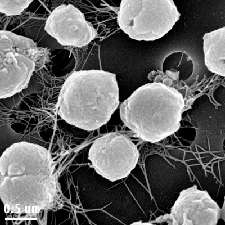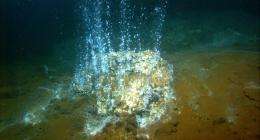Seeking Life's Shadow

They haven't yet figured out how to draw blood from stones, but a group of French researchers is offering new insight that could change how scientists search for signs of life in Martian rocks.
By studying the laboratory fossilization of microorganisms, scientists have caught a glimpse into how early Earth and potential Martian life might be preserved in rocks. The scientists focused on Pyrococcus abyssi and Methanocaldococcus jannaschii, extremophiles which thrive in piping hot (up to 176°F), oxygen-lacking (<0.2% of current levels) environments.
Some believe this sort of hot, anoxic environment is where life may have originated on Earth, and perhaps even on Mars.
“Environmental conditions were similar on the young terrestrial planets and traces of early Martian life may have been similarly preserved as silicified microfossils,” the scientists write in their study, which appeared in the September issue of the journal Geobiology.
On Earth, some fossils are created when microorganisms are caught in concentrated flows of silica and other minerals near hydrothermal sources. Instead of studying existing hydrothermal ocean vents or hot springs, the scientists imitated this natural fossilization process in the laboratory. This allowed them to more closely mirror the oxygen-lacking environments of Mars and the early Earth.
Effects observed in the two organisms were quite different. Most M. jannaschii cells collapsed and died within a week. They left behind only subtle organic traces after inoculation with a silica solution. Many key features of P. abyssi persisted for up to 4 months after inoculation. This created a larger window for potential preservation.
“They do fossilize a little bit, but do not survive the test of time,” says Frances Westall, a paleobiologist at the Centre National de la Recherche Scientifique in Orleans, France, who supervised the research team’s work.
Dorothy Oehler of NASA’s Johnson Space Center, who was not involved in the study, says that even though the organisms in the study did not fossilize particularly well, many ancient fossils have been found preserved in silica. This indicates that other microbes studied under different conditions might offer a higher potential for fossilization.
The scientists did note in their study that a particular substance produced by the microbes has more staying power. This substance could provide proof of life even when the actual bodies are long gone.
Tell-Tale Traces
The dead, fossilized bodies of microorganisms can be difficult to find in ancient rocks. Many rocks have been chewed up and spit out by Earth's tectonic recycling program, which pulls rocks under the Earth’s crust and heats them. Other rocks that manage to avoid this geological processing are still subjected to degradation by wind or rain weathering. Scientists can work around this by looking for evidence of life that can survive over time, such as biomolecules. By searching for substances associated with life, scientists can determine whether or not life existed when the ancient rocks formed.
Some rocks are made when dirt gets trapped in biofilms -- sticky mat communities that are created when microbes excrete starch-like substances called "extracellular polymeric substances," or EPS. After the organisms in these biofilms die, the dirt in their mats turns to stone ("lithifies"). Ancient lithified biofilms could potentially still contain chemical evidence of the life that created them.
This new study notes that EPS excreted by the microbes fossilizes quickly, becoming part of the rock. Because of this, EPS could be on the list of biological substances that indicate life was once present.

Oehler points out, however, that EPS in a rock could be the result of organisms entering the pores of the rock long after it initially formed. This means that while EPS could be a red flag indicating life, additional tests must be done to determine whether the EPS is the same age as the rock or was introduced by colonizing microbes at a much later date.
Timeline for Life
Knowing when life was present is important for scientists who study the emergence of life on Earth. Many believe that life appeared 3.5 billion years ago or even earlier, but fossils dating that far back in time are highly controversial. While some argue that the microscopic forms show strong evidence of having once been life, others say these so-called ancient fossils are just non-biological mineral deposits.
Pinning down the time of life’s emergence on Earth has implications for the search for life on Mars. The environments of early Earth and Mars are thought to have been similar in the distant past. There is evidence that the Martian surface may have been covered by oceans, lakes and rivers of flowing water 3.5 billion years ago, and these water-rich conditions may have persisted episodically on the Red Planet until about 3 billion years ago. New findings show that frozen water sits below the Martian surface at this very moment. If Mars was Earth-like around the same time that life emerged on Earth, then it seems possible that life also could have emerged on Mars.
“If life appeared on Mars, there is a high probability that the traces of those life forms were preserved by fossilization with silica or other minerals,” the scientists write. “Since many ancient microfossils on Earth are preserved in a form of silica called chert, this gives high hopes for the finding of possible past Martian life forms.”
Although the rovers Spirit and Opportunity are still investigating the surface of Mars, they are not able to study the rocks in great enough detail to find evidence of life. “We had to use high-resolution imaging technology to study the microfossils,” says Westall. “We can’t do this on Mars. The bottom line is that we will probably need to study rocks that have been carefully chosen and returned from Mars.”
Source: Astrobio.net, by Shaun McCormack



















